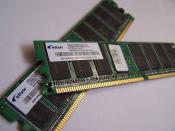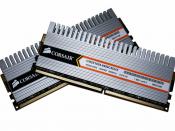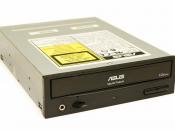Definitions of storage:
The number of instructions and amount of data a computer can store in its memory is measured in bytes. One byte contains 8 bits (short for binary digits, 0 and 1). Computers work by using pulses of voltage which represent either 0 or 1. Low voltages represent 0, high voltages represent 1. 8 bits are normally needed to store one character. A single character can be stored in one byte. We normally refer to storage capacities in terms of kilobytes (KB) or megabytes (MB).
1 KB = 1 kilobyte = 1024 bytes
1 MB = 1 048 576 bytes
1 GB = 1 gigabyte = 1000 MB
Memory (main store) and how it can be used:
There are two types of memory or main store:
read-only memory (ROM)
random-access memory (RAM)
Memory is the name given to the groups of chips inside the processing unit where data is held temporarily whilst processing takes place.
The data held in the memory is instantly available to the computer. The memory needed to run programs has increased enormously over the last few years as they have employed more icons and other graphics. Even simple laser printers now have more memory than computers did only a few years ago.
Memory is used to hold the following:
1) Programs - these may be the operating system or applications programs.
2) Input data - this is put into the memory before processing
3) Working area - this is used to store the data that is currently being processed.
4) Output data - this is put into the part of the store ready to be output to the printer.
Read-only memory (ROM):
ROM is held on a chip inside the processor and is used to hold data which cannot be changed by the user. Programs are...


